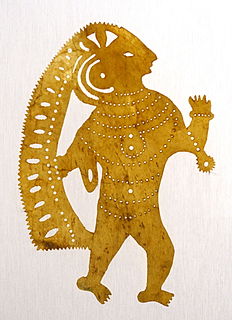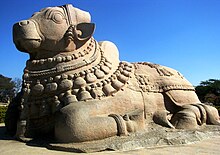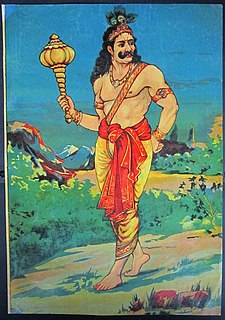
Puppetry is a form of theatre or performance that involves the manipulation of puppets – inanimate objects, often resembling some type of human or animal figure, that are animated or manipulated by a human called a puppeteer. Such a performance is also known as a puppet play. The puppeteer uses movements of her hands, arms, or control devices such as rods or strings to move the body, head, limbs, and in some cases the mouth and eyes of the puppet. The puppeteer often speaks in the voice of the character of the puppet, and then synchronizes the movements of the puppet's mouth with this spoken part. The actions, gestures and spoken parts acted out by the puppets are typically used in storytelling.

A marionette is a puppet controlled from above using wires or strings depending on regional variations. A marionette's puppeteer is called a marionettist. Marionettes are operated with the puppeteer hidden or revealed to an audience by using a vertical or horizontal control bar in different forms of theatres or entertainment venues. They have also been used in films and on television. The attachment of the strings varies according to its character or purpose.

Wayang, also known as Wajang, is a form of puppet theatre art found in Indonesia and other parts of Southeast Asia, wherein a dramatic story is told through shadows thrown by puppets and sometimes combined with human characters. The art form celebrates the Indonesian culture and artistic talent; its origins are traced to the spread of Hinduism in the medieval era and the arrival of leather-based puppet arts called Tholu bommalata from southern India.

Shadow play, also known as shadow puppetry, is an ancient form of storytelling and entertainment which uses flat articulated cut-out figures which are held between a source of light and a translucent screen or scrim. The cut-out shapes of the puppets sometimes include translucent color or other types of detailing. Various effects can be achieved by moving both the puppets and the light source. A talented puppeteer can make the figures appear to walk, dance, fight, nod and laugh.
A hand puppet is a type of puppet that is controlled by the hand or hands that occupies the interior of the puppet. Glove puppets are a variation of hand puppets. Rod puppets require one of the puppeteer's hands inside the puppet glove holding a rod which controls the head, and the puppet's body then hangs over most or all of the forearm of the puppeteer, and possibly extends further. Other parts of the puppet may be controlled by different means, e.g., by rods operated by the puppeteer's free hand, or strings or levers pulled the head or body. A smaller variety, simple hand puppets often have no significant manipulable parts at all. Finger puppets are not hand puppets as they are used only on a finger.
The dance and theatre of Laos is the primary dramatic art form of Laos' majority ethnic group, the Lao people. It is shared with the ethnic Lao that inhabit the Isan region of Thailand as well. There are mainly two types of dances, the classical dances performed in the royal courts and the folk dances now associated with morlam.

The dhalang or dalang is the puppeteer in an Indonesian wayang performance.
The dance forms of Andhra Pradesh take on a wide variety of colors, costumes, and types; and involve different settings and musical instruments. Andhra Pradesh is a state in southern India.

Karnataka has a variety of traditional arts, including folk dance and puppetry.

Togalu Gombeyaata is a puppet show unique to the state of Karnataka, India. Togalu Gombeyaata translates to a play of leather dolls in the native language of Kannada. It is a form of shadow puppetry. Karnataka Chitrakala Parishat has undertaken research on this art and has a good collection of leather puppets.

Karagöz and Hacivat are the lead characters of the traditional Turkish shadow play, popularized during the Ottoman period and then spread to most nation states that comprised the Ottoman Empire and most prominently in Turkey and Greece. In Greece, Karagöz is known by his local name Karagiozis; in Bosnia-Herzegovina, he is known by his local name Karađoz or Karadjoz.
Tamil Nadu has a rich history of art of entertainment. The three modes of entertainment classified as Iyal (Literature), Isai (Music) and Nadagam (Drama) had their roots in the rural folk theatre like Theru Koothu. Many forms of group and individual dances with the classical forms for popularity and sheer entertainment value. Some of the dance forms are performed by Tribal people. The majority of these dances are still thriving in Tamil Nadu today.

Sita Sings the Blues is a 2008 American animated musical romantic comedy-drama film written, directed, produced and animated by American artist Nina Paley. It intersperses events from the Ramayana, light-hearted but knowledgeable discussion of historical background by a trio of Indian shadow puppets, musical interludes voiced with tracks by Annette Hanshaw and scenes from the artist's own life. The ancient mythological and modern biographical plot are parallel tales, sharing numerous themes.

A puppet is an object, often resembling a human, animal or mythical figure, that is animated or manipulated by a person called a puppeteer. The puppeteer uses movements of their hands, arms, or control devices such as rods or strings to move the body, head, limbs, and in some cases the mouth and eyes of the puppet. The puppeteer often speaks in the voice of the character of the puppet, and then synchronizes the movements of the puppet's mouth with this spoken part. The actions, gestures and spoken parts acted out by the puppeteer with the puppet are typically used in storytelling. Puppetry is a very ancient form of theatre which dates back to the 5th century BC in Ancient Greece. There are many different varieties of puppets, and they are made from a wide range of materials, depending on their form and intended use. They range from very simple in construction and operation to very complex.

Tholpavakoothu is a form of shadow puppetry that is practiced in Kerala, India. It is performed using leather puppets as a ritual dedicated to Bhadrakali and is performed in Devi temples in specially built theatres called koothumadams. This art form is especially popular in the Palakkad, Thrissur and Malappuram districts of Kerala.

Water puppetry is a tradition that dates back as far as the 11th century when it originated in the villages of the Red River Delta area of northern Vietnam. Today's Vietnamese water puppetry is a unique variation on the ancient Asian puppet tradition.

Rabana Chhaya is a form of shadow puppetry from the eastern Indian state of Odisha.

Wayang kulit is a traditional performing arts of puppet-shadow play found in the cultures of Java, Bali, and Lombok, in Indonesia. In a wayang kulit performance, the puppet figures are rear-projected on a taut linen screen with a coconut-oil light. The Dalang manipulates carved leather figures between the lamp and the screen to bring the shadows to life.
The history of animation in India can be traced to the early 20th century. Precursors to modern animation such as shadow puppets and slide shows entertained audiences before the advent of the cinema. Pioneers such as Dadasaheb Phalke, Gunamoy Banerjee, K.S Gupte and G.K Ghokle kept the tradition of animation alive during the first half of the 20th century. Such individuals were usually self-taught and were inspired by foreign cartoons.























